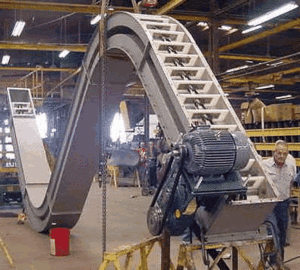Difference between revisions of "Drag Conveyors"
| Line 7: | Line 7: | ||
* Please start editing this page after the /noinclude | * Please start editing this page after the /noinclude | ||
* -------------------------------------------------></noinclude> | * -------------------------------------------------></noinclude> | ||
[[File:Drag conveyors.gif|right|thumb|Drag Conveyors]] | |||
'''Drag Conveyor''' is a good way to move material in one direction when a change in elevation is desired. It can also be used as a metering device if the inlet of the drag has a strike off as the material leaves the inlet. The style of chain and flight for the drag conveyor is determined by what material the drag is moving and whether there will be a change in elevation. | |||
Drag conveyors can also be part of a quench or settling tank. The drag in applications like this will slowly drag material across the bottom of the tank, up one side and out of the tank. | |||
One of the benefits of drag conveyors is that they can handle an extreme range in material particle size, from ash finds to large clinkers. They can also be designed to handle very abrasive material. | |||
These conveyors are used for metering or conveying. | |||
They are available in single or double chain versions. All have stairways and handrails. The [[Conveyors]] are lined with durable Ni-hard wear plates, unconditionally guaranteed to last two million tons. | |||
Latest revision as of 07:47, 23 August 2012
Drag Conveyor is a good way to move material in one direction when a change in elevation is desired. It can also be used as a metering device if the inlet of the drag has a strike off as the material leaves the inlet. The style of chain and flight for the drag conveyor is determined by what material the drag is moving and whether there will be a change in elevation.
Drag conveyors can also be part of a quench or settling tank. The drag in applications like this will slowly drag material across the bottom of the tank, up one side and out of the tank. One of the benefits of drag conveyors is that they can handle an extreme range in material particle size, from ash finds to large clinkers. They can also be designed to handle very abrasive material.
These conveyors are used for metering or conveying. They are available in single or double chain versions. All have stairways and handrails. The Conveyors are lined with durable Ni-hard wear plates, unconditionally guaranteed to last two million tons.
